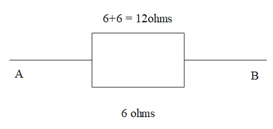
A uniform metallic wire has a resistance of 18 Ω and is bent into an equilateral triangle. Then, the resistance between any two vertices of the triangle is
(A) $8\Omega $
(B) $12\Omega $
(C) $4\Omega $
(D) $2\Omega $
Answer
556.8k+ views
Hint
When we bend the wire into an equilateral triangle, then the resistance divides equally into three parts for the three equal sides. We need to calculate the division resistance divided and find the equivalent resistance of the whole combination.
Formula used: In this question, we will be using the following formula,
${R_{eq}} = {R_1} + {R_2} + {R_3} + ....$ where ${R_{eq}}$ is the equivalent resistance when the resistances are placed in series.
$\dfrac{1}{{{R_{eq}}}} = \dfrac{1}{{{R_1}}} + \dfrac{1}{{{R_2}}} + \dfrac{1}{{{R_3}}} + ....$ where ${R_{eq}}$ is the equivalent resistance when the resistances are placed in a parallel circuit.
Complete step by step answer
Let us consider the two vertices of the triangle as A and B.
When we bend the metallic wire into an equilateral triangle, we get the figure as,

So when we bend the wire into three equal parts, the resistance of the metallic wire is divided equally for the three sides of the triangle. Now, when we try to simplify the diagram to see the combination of the resistances, we get a figure as,

In the top wire, the resistances are in series, so we can calculate the total resistance using the formula ${R_{eq}} = {R_1} + {R_2} + {R_3} + ....$
We can substitute, ${R_1} = {R_2} = 6\Omega $
Hence we get
${R_{eq1}} = 6 + 6 = 12\Omega $
Now, we see that the base of the triangle has 6 ohms resistance and it is parallel to the above side.
Then we can use the formula, $\dfrac{1}{{{R_{eq}}}} = \dfrac{1}{{{R_1}}} + \dfrac{1}{{{R_2}}} + \dfrac{1}{{{R_3}}} + ....$
Substituting ${R_1} = 6\Omega $ and ${R_2} = {R_{eq}} = 12\Omega $ we get
$\dfrac{1}{{{R_{eq}}}} = \dfrac{1}{6} + \dfrac{1}{{12}}$
Taking LCM as 12
$\dfrac{1}{{{R_{eq}}}} = \dfrac{{2 + 1}}{{12}} = \dfrac{1}{4}$
On taking reciprocal we get,
${R_{eq}} = 4\Omega $
Thus, the resistance between the two vertices A and B is 4 ohms.
Hence, the correct answer is option (C).
Note
The resistance of a wire depends on the resistivity of the material, the length of the wire and the area of the cross section. Here the wire is bending into three equal parts. So considering the area of the cross section to be the same everywhere, we have considered the resistance gets divided into three equal parts.
When we bend the wire into an equilateral triangle, then the resistance divides equally into three parts for the three equal sides. We need to calculate the division resistance divided and find the equivalent resistance of the whole combination.
Formula used: In this question, we will be using the following formula,
${R_{eq}} = {R_1} + {R_2} + {R_3} + ....$ where ${R_{eq}}$ is the equivalent resistance when the resistances are placed in series.
$\dfrac{1}{{{R_{eq}}}} = \dfrac{1}{{{R_1}}} + \dfrac{1}{{{R_2}}} + \dfrac{1}{{{R_3}}} + ....$ where ${R_{eq}}$ is the equivalent resistance when the resistances are placed in a parallel circuit.
Complete step by step answer
Let us consider the two vertices of the triangle as A and B.
When we bend the metallic wire into an equilateral triangle, we get the figure as,

So when we bend the wire into three equal parts, the resistance of the metallic wire is divided equally for the three sides of the triangle. Now, when we try to simplify the diagram to see the combination of the resistances, we get a figure as,

In the top wire, the resistances are in series, so we can calculate the total resistance using the formula ${R_{eq}} = {R_1} + {R_2} + {R_3} + ....$
We can substitute, ${R_1} = {R_2} = 6\Omega $
Hence we get
${R_{eq1}} = 6 + 6 = 12\Omega $
Now, we see that the base of the triangle has 6 ohms resistance and it is parallel to the above side.
Then we can use the formula, $\dfrac{1}{{{R_{eq}}}} = \dfrac{1}{{{R_1}}} + \dfrac{1}{{{R_2}}} + \dfrac{1}{{{R_3}}} + ....$
Substituting ${R_1} = 6\Omega $ and ${R_2} = {R_{eq}} = 12\Omega $ we get
$\dfrac{1}{{{R_{eq}}}} = \dfrac{1}{6} + \dfrac{1}{{12}}$
Taking LCM as 12
$\dfrac{1}{{{R_{eq}}}} = \dfrac{{2 + 1}}{{12}} = \dfrac{1}{4}$
On taking reciprocal we get,
${R_{eq}} = 4\Omega $
Thus, the resistance between the two vertices A and B is 4 ohms.
Hence, the correct answer is option (C).
Note
The resistance of a wire depends on the resistivity of the material, the length of the wire and the area of the cross section. Here the wire is bending into three equal parts. So considering the area of the cross section to be the same everywhere, we have considered the resistance gets divided into three equal parts.
Recently Updated Pages
Master Class 12 Business Studies: Engaging Questions & Answers for Success

Master Class 12 Economics: Engaging Questions & Answers for Success

Master Class 12 English: Engaging Questions & Answers for Success

Master Class 12 Maths: Engaging Questions & Answers for Success

Master Class 12 Social Science: Engaging Questions & Answers for Success

Master Class 12 Chemistry: Engaging Questions & Answers for Success

Trending doubts
What are the major means of transport Explain each class 12 social science CBSE

Which are the Top 10 Largest Countries of the World?

Draw a labelled sketch of the human eye class 12 physics CBSE

Explain sex determination in humans with line diag class 12 biology CBSE

The pH of the pancreatic juice is A 64 B 86 C 120 D class 12 biology CBSE

Give 10 examples of unisexual and bisexual flowers




